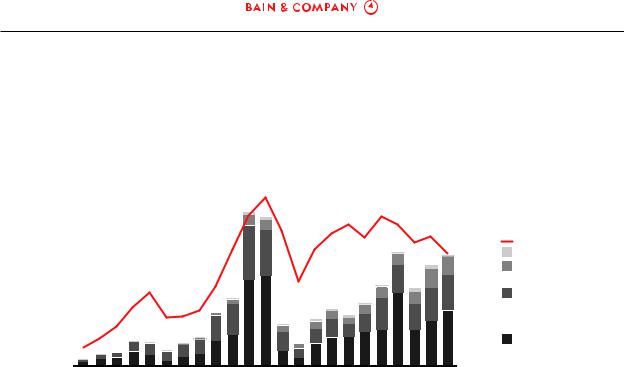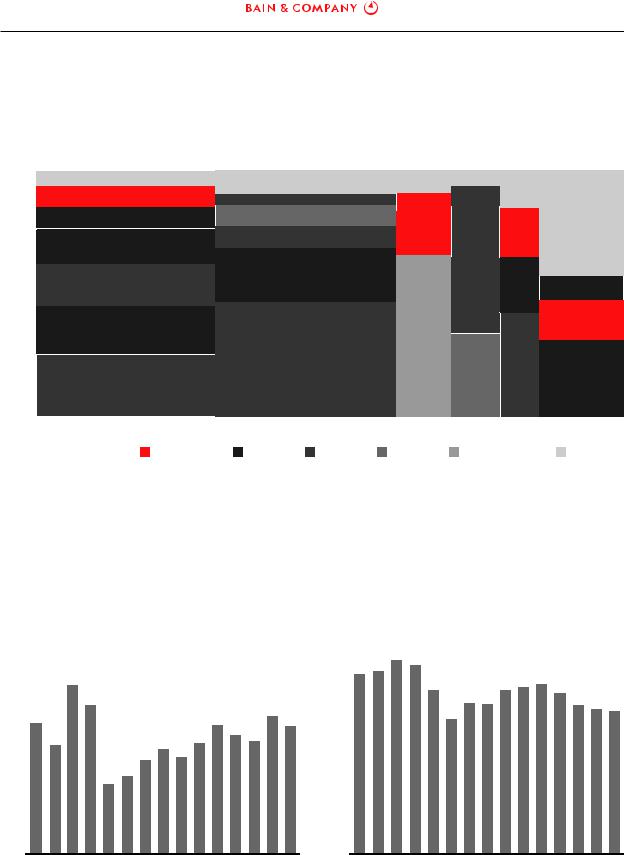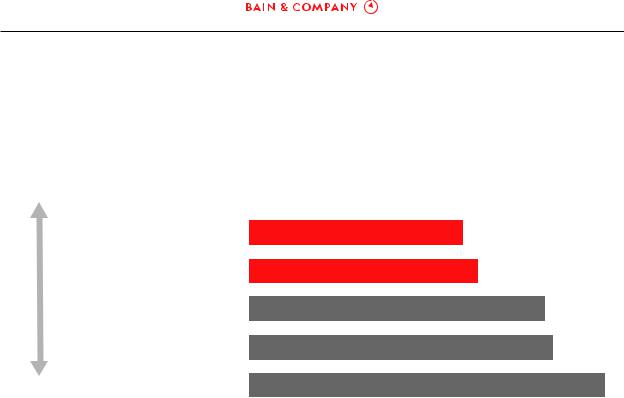
bain_report_private_equity_report_20
.pdf
vk.com/id446425943
GLOBAL PRIVATE EQUITY REPORT 2019
vk.com/id446425943
About Bain & Company’s Private Equity business
Bain & Company is the leading consulting partner to the private equity (PE) industry and its stakeholders. PE consulting at Bain has grown eightfold over the past 15 years and now represents about one quarter of the firm’s global business. We maintain a global network of more than 1,000 experienced professionals serving PE clients. Our practice is more than triple the size of the next largest consulting company serving PE firms.
Bain’s work with PE firms spans fund types, including buyout, infrastructure, real estate and debt. We also work with hedge funds, as well as many of the most prominent institutional investors, including sovereign wealth funds, pension funds, endowments and family investment offices. We support our clients across a broad range of objectives:
Deal generation. We help develop differentiated investment theses and enhance deal flow by profiling industries, screening companies and devising a plan to approach targets.
Due diligence. We help support better deal decisions by performing integrated due diligence to assess the market dynamics, a target’s competitive position and margin expansion opportunities, and by providing a post-acquisition agenda.
Immediate post-acquisition. We support the pursuit of rapid returns by developing a strategic valuecreation plan for the acquired company, leading workshops that align management with strategic priorities, and directing focused initiatives or wholesale transformations.
Ongoing value addition. We help increase company value by supporting revenue enhancement and cost reduction and by refreshing strategy.
Exit. We help ensure that funds maximize returns by identifying the optimal exit strategy, preparing the selling documents and prequalifying buyers.
Firm strategy and operations. We help PE firms develop distinctive ways to achieve continued excellence by devising differentiated strategies, maximizing investment capabilities, developing sector specialization and intelligence, enhancing fund-raising, improving organizational design and decision making, and enlisting top talent.
Institutional investor strategy. We help institutional investors develop best-in-class investment programs across asset classes, including private equity, infrastructure and real estate. Topics we address cover asset class allocation, portfolio construction and manager selection, governance and risk management, and organizational design and decision making. We also help institutional investors expand their participation in private equity, including through coinvestment and direct investing opportunities.
Bain & Company, Inc.
131 Dartmouth Street
Boston, Massachusetts 02116 USA
Tel: +1 617 572 2000

vk.com/id446425943
Global Private Equity Report 2019
Contents
The beginning of the rest of the story?. . . . . . . . . . . . . . . . . . . . . . . . . . . . pg. .1
1.The private equity market in 2018: What happened?. . . . . . . . . . . . . . . . . . pg. .3
Investments: More strength, same challenges . . . . . . . . . . . . . . . . . . . . . . . pg. .3 Spotlight on China: Navigating the new economy . . . . . . . . . . . . . . . . . . pg. .13 Exits: Strategic buyers keep the party going. . . . . . . . . . . . . . . . . . . . . . . pg. .17 Fund-raising: The capital continues to flow. . . . . . . . . . . . . . . . . . . . . . . . pg. .21 Spotlight on GP equity stakes: Will the bonanza continue?. . . . . . . . . . . . . pg. .27 Returns: Despite a drop, PE still outperforms. . . . . . . . . . . . . . . . . . . . . . . pg. .32 Key takeaways. . . . . . . . . . . . . . . . . . . . . . . . . . . . . . . . . . . . . . . . . . . pg. .36
2.What’s happening now: The strategies shaping private equity
in 2019 and beyond . . . . . . . . . . . . . . . . . . . . . . . . . . . . . . . . . . . . . . . pg. .37
Buy-and-build: Powerful strategy, hard to pull off.. . . . . . . . . . . . . . . . . . . pg. .37 Merger integration: Stepping up to the challenge . . . . . . . . . . . . . . . . . . . pg. .46 Adjacency strategy: Taking another shot at diversification . . . . . . . . . . . . . pg. .58 Advanced analytics: Delivering quicker and better insights. . . . . . . . . . . . . pg. .67
3. Private multiples are ascendant: Is this the new normal?. . . . . . . . . . . . . . . pg. .73
i

vk.com/id446425943
Global Private Equity Report 2019
ii

vk.com/id446425943
Global Private Equity Report 2019
The beginning of the rest of the story?
Dear Colleague:
The past five years have been ones of unprecedented success for the private equity industry. During that span, more money has been raised, invested and distributed back to investors than in any other period in the industry’s history. Private investment in general, and private equity in particular, seems to be on a secular penetration curve that has no end in sight. Yet, there are also some cautionary notes to sound.
Returns, while still strong relative to other asset classes, have slowly declined toward public market averages during the period. Persistent high prices, volatile capital markets, US–China trade arguments, Brexit worries and, of course, the ever-present threat of recession have injected a sense of uncertainty that dealmakers dislike. The pace of technological change is also increasing in almost every industry, making it harder to forecast winners and losers. So, while the good times are rolling, some bells of worry are tolling.
In this, Bain’s 10th-anniversary Global Private Equity Report, we look fearlessly at the industry’s strengths, its challenges and the evolutionary path that lies ahead. In addition to the critical statistics that characterize PE industry performance, you’ll find our assessment of how to do “buy-and-builds” properly and why this tactic is increasing in popularity. Building on last year’s assertion that PE firms need to increase their 10% share of the approximately 40,000 M&A deals done globally each year, we discuss how firms are building merger integration muscles to better compete with corporate buyers, and why the integration process should begin during due diligence. We also take a hard look at adjacency strategy 2.0 and the new wave of equity products that many PE firms are moving into aggressively, hoping to find higher returns and more productive ways to invest capital at scale.
In addition, we zero in on exciting topics such as advanced analytics, which speeds insight in both diligence and post-close value addition; liquidity solutions for general partners; and the Chinese PE market, which is on the leading edge in areas like technology.
We close our 2019 review of important trends in private equity by getting out our crystal ball. It’s a bit cloudy (as is everyone’s), but we see fundamental shifts happening in capital markets that are likely to drive a long-term trend toward much larger private capital (and private equity) opportunities vs. traditional public equity models. This ongoing movement will have seismic impacts for providers of capital, investors of that capital and for the companies owned by a widening variety of private models. It portends a future in which a much larger share of capital flows into private markets. Perhaps this is indeed the beginning of “the rest of the story” for the PE industry.
Hugh MacArthur
Head of Global Private Equity
1

vk.com/id446425943
Global Private Equity Report 2019
2

vk.com/id446425943
Global Private Equity Report 2019
1. The private equity market in 2018: What happened?
As the current economic expansion chugged into its ninth full year in 2018, the global private equity (PE) industry continued to make deals, find exits and raise capital at a historic five-year pace. Limited partners (LPs) remain highly enthusiastic and have continued to flood the market with fresh capital. Keeping the momentum going, however, has hardly been easy.
Chronically heavy competition has driven deal multiples to historic highs, and growing jitters about an eventual economic downturn are affecting decision making, from diligence to exit planning. For general partners (GPs), putting record amounts of capital to work means getting comfortable with a certain level of discomfort when investing. They are paying prices they swore they would never pay and looking to capture value that may prove elusive post-close. The most effective GPs are stepping up their game to identify targets and sharpen diligence, while simultaneously planning for the worst. In Sections 2 and 3, we’ll explore several strategies firms are using to make the most of an increasingly difficult market. In the meantime, here’s what happened in 2018.
• • •
Investments: More strength, same challenges
Amid heavy pressure to do deals, the PE industry saw another impressive surge in investment value in 2018. Fierce competition and rising asset prices continued to constrain deal count—pushing down the number of individual transactions by 13%, to 2,936 worldwide—but total buyout value jumped 10% to $582 billion (including add-on deals), capping the strongest five-year run in the industry’s history
(see Figure 1.1).
While the current investment cycle hasn’t been a steady upward march, especially in terms of deal count, it has shown great resilience and overall strength. Every year since 2014 has produced higher deal value than any year in the previous cycle, with the exception of the peak in 2006 and 2007. Over this period, the industry has benefited from an unprecedented wave of investor interest, buttressed by ebullient equity markets, low interest rates and steady GDP growth in the US and Europe. For GPs, it has been a remarkable run.
Predictably, experts are debating how long the good times can last. Only one other US recovery on record (from 1991 to 2001) has extended as long as this one. While GDP growth in the West remains strong, US interest rates are rising as inflation picks up in the US and Europe. Slowing growth in China, global trade tensions, ongoing uncertainty about Brexit and year-end market volatility are all fueling concern that this cycle may be running its course.
For PE firms, however, the question isn’t so much when the next downturn will appear as how to negotiate it successfully when it does. With record amounts of capital to invest, it doesn’t pay to sit idle trying to time the downturn. Instead, GPs are finding ways to cope with a growing level of macro uncertainty
3

vk.com/id446425943
Global Private Equity Report 2019
Figure 1.1: Rising deal value in 2018 capped the strongest five-year stretch in history, while deal count reflected stiff competition and rising asset prices
Global buyout deal value (including add-on deals) |
Deal count |
$1,000B |
5,000 |
800 |
|
|
|
4,000 |
600 |
|
|
|
3,000 |
400 |
|
|
|
2,000 |
200 |
|
|
|
1,000 |
0 |
|
|
|
0 |
1996 97 98 99 00 01 02 03 04 05 06 07 08 09 10 11 12 13 14 15 16 17 18 |
||||
Add-on count |
9 |
17 25 25 27 33 29 27 28 29 29 33 36 36 37 41 40 40 45 48 48 49 42 |
||
percentage |
|
|
|
|
Add-on value |
14 16 16 15 20 16 |
8 |
11 12 17 10 11 13 21 12 25 21 14 31 43 21 24 23 |
|
percentage |
|
|
|
|
|
CAGR |
|
(17–18) |
Total count |
–13% |
Rest of world |
–53% |
Asia-Pacific |
–4% |
Europe |
9% |
North America |
22% |
Notes: Excludes loan-to-own transactions and acquisitions of bankrupt assets; based on announcement date; includes announced deals that are completed or pending, with data subject to change; geography based on target’s location
Source: Dealogic
and planning carefully for how they can profit from the downturn. With the global financial crisis fresh in their memories, firms are focusing their diligence much more intently on downside scenarios this time around. They learned valuable lessons during the crisis about what holds up well through the cycle—or not—and are adjusting accordingly. Even within a sector like healthcare, widely viewed as recession-resistant, there were subsector differences in performance worth noting. Healthcare support services, for instance, produced multiples of better than two times invested capital, while healthcare equipment and pharmaceuticals fared less well, according to CEPRES, a digital investment platform and transactional network for the private capital markets (see Figure 1.2).
Spotting pockets of opportunity has been a challenge even in the up-cycle. For GPs, finding the right asset at the right price was the biggest constraint on doing deals in 2018. That helps explain why the number of transactions has remained stubbornly flat, bouncing around between 3,000 and 4,000 buyouts per year since 2010. Indeed, despite the industry’s impressive showing over the last five years, it has failed to carve out a larger share of the global market for mergers and acquisitions, which has hovered around 40,000 transactions per year for a decade (see Figure 1.3).
When asked what most gets in the way of closing more deals, GPs cite the same challenges they have faced for years: high deal multiples, a dearth of attractive targets and stiff competition (see Figure 1.4). GPs are clearly hungry to do more deals, but when they find attractive assets, they consistently encounter aggressive corporate buyers willing to push up auction prices. These buyers are strategic,
4

vk.com/id446425943
Global Private Equity Report 2019
Figure 1.2: Returns during the global financial crisis were all over the map—between sectors and within sectors
Global buyout equity capital invested, by sector and subsector (2006–08)
100% |
Miscellaneous |
|
Miscellaneous |
Misc. |
Misc. |
|
|
|
|
|
Misc. |
|
|||||
|
Transportation services |
Specialized consumer services |
Internet |
Pharma and |
|
|||
|
biotech |
|
|
|||||
|
|
|
|
|
||||
80 |
Natural resources/energy equipment |
Food and beverages |
|
|
|
Miscellaneous |
||
and services |
|
|
Healthcare |
|
||||
|
|
|
|
Semi- |
Banks |
|||
|
|
|
Textiles |
|
facilities |
|
||
|
Construction |
|
|
conductors |
|
|
||
|
|
|
|
|
|
|
||
60 |
|
|
Travel and leisure |
|
|
|
|
|
|
General industrials |
|
|
Insur- |
Telecom |
|||
|
|
|
Other tech |
Healthcare |
||||
|
|
|
|
|
ance |
infrastructure |
||
|
|
|
|
|
|
equipment |
||
|
|
|
|
|
|
|
Natural resources/ |
|
40 |
|
|
|
|
|
|
|
|
Chemicals |
|
Retail |
|
|
|
|
energy |
|
|
|
|
|
|
|
|||
|
|
|
|
|
|
infrastructure |
||
20 |
|
|
|
|
Software |
Healthcare |
Services |
Telecom |
|
|
|
|
|
support |
|
equipment |
|
|
|
|
|
|
|
|
||
|
Business support services |
Media |
|
|
services |
|
||
|
|
|
|
and services |
||||
0 |
Industrials |
|
Consumer |
Technology |
Health- |
Financial |
Other |
|
|
|
|||||||
|
|
|
|
|
|
care |
services |
|
|
Gross pooled MOIC |
Less than 1.0x |
1.0x–1.5x |
1.5x–2.0x |
2.0x–2.5x |
Greater than 2.5x |
Unavailable |
|
Notes: Includes realized and unrealized buyout deals with invested equity capital of $50 million or more and initial investment between January 1, 2006, and December 31, 2008; MOIC stands for multiple of invested capital
Source: CEPRES PE.Analyzer
Figure 1.3: Private equity is not increasing its share of the total market for mergers and acquisitions
Deal value
Global buyout share of total M&A 30%
Deal count
Global buyout share of total M&A 15%
20 |
|
|
|
|
|
|
|
|
|
|
10 |
10 |
|
|
|
|
|
|
|
|
|
|
5 |
0 |
|
|
|
|
|
|
|
|
|
|
0 |
200405 06 07 |
08 |
09 |
10 |
11 |
12 |
13 |
14 |
15 |
16 |
17 |
18 |
200405 |
06 |
07 08 |
09 |
10 |
11 |
12 |
13 |
14 |
15 |
16 |
17 |
18 |
Notes: Total M&A is the sum of corporate M&A and buyouts, including add-ons; corporate M&A excludes transactions in which the acquirer is a government entity; based on announcement date; includes announced deals that are completed or pending, with data subject to change
Source: Dealogic
5

vk.com/id446425943
Global Private Equity Report 2019
Figure 1.4: High multiples, a dearth of targets and stiff competition continue to be the biggest challenges for PE firms looking to close deals
What do you anticipate to be the biggest challenges for PE dealmakers in 2018?
More important High transaction multiples 
 2.3
2.3
Deal sourcing/ lack of quality assets
Competition
Political uncertainty
Regulatory environment
2.9
3.1
4.0
4.1
Less important |
Access to financing |
|
|
|
|
4.8 |
||
|
|
|
|
|
|
|
|
|
|
0 |
1 |
2 |
3 |
4 |
5 |
||
Mean of responses by category (1 as most important and 7 as least)
Source: Crystal Ball Report 2018, PitchBook Data, Inc.
meaning they will pay more to advance corporate objectives and capture synergies. Increasingly, they are showing up at all ends of the market as they search for ways to spur new growth through acquisition.
Large deals, especially a spate of very large carve-out transactions, helped boost deal value in North America by 22% in 2018. The year’s largest buyout was the $17 billion carve-out of Thomson Reuters’ Financial & Risk unit, led by Blackstone and the Canada Pension Plan Investment Board. Large public- to-private (P2P) deals, such as KKR’s $9.6 billion leveraged buyout (LBO) of Envision Healthcare, also contributed to the bump in value. The strong P2P activity in the US pushed the value of these deals globally to its highest level since the previous take-private boom in 2006–07 (see Figure 1.5). The reason: Despite the run-up in equity prices, public investors often undervalue companies they don’t understand. “If you have a complicated story, you’re not really welcomed so much in the public market,” said Josh Harris, the cofounder of Apollo Global Management, which took LifePoint Health private in 2018. “That is creating a very fertile hunting ground for private equity, and we do see more opportunities here.”
Sponsor-to-sponsor deals also provided a rich vein of opportunity in 2018. That was especially true in Europe, where deals between PE funds dominated in terms of both value and deal count, as they have since 2010. Partners Group led a consortium including CDPQ and the Ontario Teachers’ Pension Plan in the $5.4 billion acquisition of Techem, a global leader in heat and water submetering services, from Macquarie. EQT acquired Azelis from Apax Partners for $2.3 billion. It was the fourth consecutive sponsor-to-sponsor transaction for Azelis, a global distributor of specialty chemicals and food ingredients.
6
